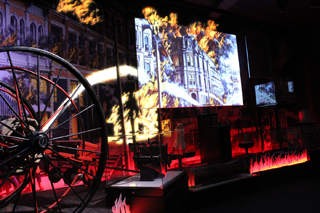|
Subscribe / Renew |
|
|
Contact Us |
|
| ► Subscribe to our Free Weekly Newsletter | |
| home | Welcome, sign in or click here to subscribe. | login |
Architecture & Engineering
| |
 Museum of History & Industry Museum of History & Industry |
January 7, 2013
MOHAI's unique exhibits deliver surprising facts in surprising ways
Weatherhead Experience Design Group

Weatherhead
|
We all wanted to take advantage of this opportunity to offer something unique to visitors by allowing them to explore history through a highly interactive and dynamic experience. MOHAI could also offer visitors a place to hang out, experience history as it relates to their lives, and gain new civic literacy skills.
One issue was how to take advantage of the armory’s drill hall, now called the Faye G. Allen Grand Atrium. Ann Farrington, the museum’s creative director, came up with the idea of integrating vertical structures into the exhibit space to provide the dynamic gesture we were looking for.
Each of the tower structures was assigned a theme such as diversity or industry. We also established the content themes for the exhibition that guided the choice of topics, stories, artifacts and delivery mechanisms.
Elements of surprise
MOHAI is unique in that it takes history right up to the present day, something history museums do not generally do. The atrium presents contemporary topics inside the towers, while upstairs the tower content coincides thematically and chronologically with the timeline approach to the exhibition layout. For instance, in the “Shaping Our City”-themed tower, visitors on the ground floor are interviewed while upstairs the tower features oral histories of people who shaped the city in the past.
MOHAI’s collection contains some very interesting and sometimes quirky objects ranging from the original Dog House restaurant sign to Eddie Bauer’s stuffed cougar. These artifacts are not necessarily key to many of the stories we wanted to tell, but since they speak to Seattle’s unique, sometimes eccentric style, we decided to display these artifacts together in a large grid structure that would be a dominant feature of the atrium space.
Originally, this was going to be a media-driven artifact theater show where the artifacts would argue with one another about their historical contributions, but it was concluded after some consideration that a programmed show in the atrium might be too disruptive. Instead, the Pacific Studio design team converted the grid of artifacts into a delightful giant set of mechanical interactives.
We established an exhibit main message at the time: “MOHAI is a place to make unexpected discoveries in unique ways that make the Puget Sound region make sense.” This message was inspired by the armory’s unique number of little areas to explore, portholes to peek through, and the opportunity to create interesting experiences in the vast open space and height offered by the grand atrium.
We also developed an exhibit vision: “To create a new way of experiencing a history museum based upon the visitors’ interests, curiosity, and the delight of discovery and surprise.”
A timeline approach to the exhibits was established using the element of surprise to tell stories that may surprise visitors. Each segment of the exhibition is built around a surprising concept, often delivered in a surprising way. An example for Seattle’s Great Fire: “How could a fire that demolished 26 square blocks possibly be beneficial to Seattle?”
The Great Fire object theater experience is a good illustration of a surprising fact delivered in a surprising way. The story is more about the aftermath of the fire and the incredible Seattle spirit that enabled the downtown to be rebuilt quickly than it is about destruction and loss. The spirited presentation conveys the main story in a unique and memorable way and conforms to our vision of creating new ways to experience a history museum.
Doing history
We paid attention to different learning preferences, which guided our development of exhibits that were not only visual but auditory, tactile and kinesthetic (requiring physical interaction with content). We wanted visitors to “do history” rather than passively read about it. Integrated with the storyline of text, photos and artifacts are 14 videos, two theater installations,14 media-driven interactives and 12 mechanical interactives.
In “Hammering Out History,” visitors build the story of statehood and the railroad by hammering on one spike at a time. In the Gold Rush exhibit, visitors use a one-armed bandit to see the fortune and fate of prospectors and their own fate.
In “How Far Would You Go?” visitors literally walk the walk to show their commitment to taking civic action on issues they care about. For the Canwell hearings interactive we wrote a script for visitors to interact with each other rather than with a computer.
Elsewhere, we chose to present entire exhibits, such as for the Treaty of Point Elliott, on large multitouch screens that would attract attention with beautiful designs and allow people to access more information and to share the experiences. The Microsoft interactive is not merely an activity, but actually the entire exhibit delivered on computer rather than with labels on the wall.
Where we wanted visitors to be able to collaborate socially we created touch-table interactives where four people can engage with content at the same time. To keep our promise to relate to visitors’ current lives, we continually juxtapose then and now in the exhibits and interactives, and we gather opinions and data from visitors throughout the interactive experiences, which we display downstairs on a multitouch table that shows in real time visitors’ cumulative responses and opinions on civic topics.
The low ceiling height in the mezzanine and some of the historic preservation requirements made integrating so much different media a challenge, so many ideas were discarded for lack of space. But good acoustic techniques and audio delivery strategies made it possible to integrate far more media than one would normally expect to be possible in this space.
Visitors will let MOHAI know, but I believe we met the goal of creating a unique kind of history museum, one that invites visitors of all types to engage not only conceptually, but physically, emotionally and socially with content that imparts civic literacy from examples of the past, and perhaps most importantly, the present.
Andrea Weatherhead is principal of the Weatherhead Experience Design Group.
Other Stories:
- Faced with a sloped floor, MOHAI crews rolled with it
- Making a new home for history on Lake Union
- A history museum that also shows our present and future



